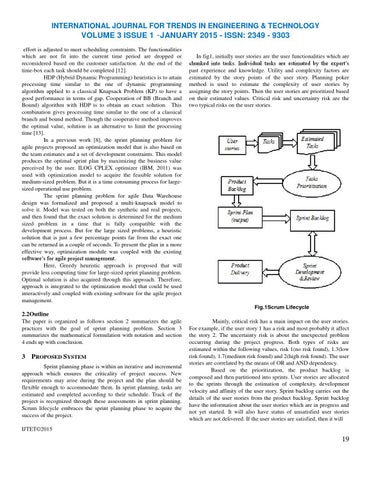INTERNATIONAL JOURNAL FOR TRENDS IN ENGINEERING & TECHNOLOGY
VOLUME 3 ISSUE 1 –JANUARY 2015 - ISSN: 2349 - 9303 effort is adjusted to meet scheduling constraints. The functionalities which are not fit into the current time period are dropped or reconsidered based on the customer satisfaction. At the end of the time-box each task should be completed [12]. HDP (Hybrid Dynamic Programming) heuristics is to attain processing time similar to the one of dynamic programming algorithm applied to a classical Knapsack Problem (KP) to have a good performance in terms of gap. Cooperation of BB (Branch and Bound) algorithm with HDP is to obtain an exact solution. This combination gives processing time similar to the one of a classical branch and bound method. Though the cooperative method improves the optimal value, solution is an alternative to limit the processing time [13]. In a previous work [8], the sprint planning problem for agile projects proposed an optimization model that is also based on the team estimates and a set of development constraints. This model produces the optimal sprint plan by maximizing the business value perceived by the user. ILOG CPLEX optimizer (IBM, 2011) was used with optimization model to acquire the feasible solution for medium-sized problem. But it is a time consuming process for largesized operational use problem. The sprint planning problem for agile Data Warehouse design was formalized and proposed a multi-knapsack model to solve it. Model was tested on both the synthetic and real projects, and then found that the exact solution is determined for the medium sized problem in a time that is fully compatible with the development process. But for the large sized problems, a heuristic solution that is just a few percentage points far from the exact one can be returned in a couple of seconds. To present the plan in a more effective way, optimization module was coupled with the existing software‘s for agile project management. Here, Greedy heuristic approach is proposed that will provide less computing time for large-sized sprint planning problem. Optimal solution is also acquired through this approach. Therefore, approach is integrated to the optimization model that could be used interactively and coupled with existing software for the agile project management.
In fig1, initially user stories are the user functionalities which are chunked into tasks. Individual tasks are estimated by the expert‘s past experience and knowledge. Utility and complexity factors are estimated by the story points of the user story. Planning poker method is used to estimate the complexity of user stories by assigning the story points. Then the user stories are prioritized based on their estimated values. Critical risk and uncertainty risk are the two typical risks on the user stories.
Fig.1Scrum Lifecycle
2.2Outline The paper is organized as follows section 2 summarizes the agile practices with the goal of sprint planning problem. Section 3 summarizes the mathematical formulation with notation and section 4 ends up with conclusion.
3 PROPOSED SYSTEM Sprint planning phase is within an iterative and incremental approach which ensures the criticality of project success. New requirements may arise during the project and the plan should be flexible enough to accommodate them. In sprint planning, tasks are estimated and completed according to their schedule. Track of the project is recognized through these assessments in sprint planning. Scrum lifecycle embraces the sprint planning phase to acquire the success of the project.
Mainly, critical risk has a main impact on the user stories. For example, if the user story 1 has a risk and most probably it affect the story 2. The uncertainty risk is about the unexpected problem occurring during the project progress. Both types of risks are estimated within the following values, risk 1(no risk found), 1.3(low risk found), 1.7(medium risk found) and 2(high risk found). The user stories are correlated by the means of OR and AND dependency. Based on the prioritization, the product backlog is composed and then partitioned into sprints. User stories are allocated to the sprints through the estimation of complexity, development velocity and affinity of the user story. Sprint backlog carries out the details of the user stories from the product backlog. Sprint backlog have the information about the user stories which are in progress and not yet started. It will also have status of unsatisfied user stories which are not delivered. If the user stories are satisfied, then it will
IJTET©2015
19
